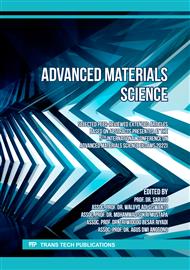[1]
S.-H. Yu, J.-Y. Uan, and T.-L. Hsu, Effects of concentrations of NaCl and organic acid on generation of hydrogen from magnesium metal scrap,, Int. J. Hydrogen Energy, vol. 37, no. 4, p.3033–3040, 2012, doi: https://doi.org/10.1016/j.ijhydene.2011.11.040.
DOI: 10.1016/j.ijhydene.2011.11.040
Google Scholar
[2]
H. H. Funke, H. Diaz, X. Liang, C. S. Carney, A. W. Weimer, and P. Li, Hydrogen generation by hydrolysis of zinc powder aerosol,, Int. J. Hydrogen Energy, vol. 33, no. 4, p.1127–1134, 2008, doi: https://doi.org/10.1016/j.ijhydene.2007.12.061.
DOI: 10.1016/j.ijhydene.2007.12.061
Google Scholar
[3]
C. B. Porciúncula, N. R. Marcilio, I. C. Tessaro, and M. Gerchmann, Production of hydrogen in the reaction between aluminum and water in the presence of NaOH and KOH,, Brazilian J. Chem. Eng., vol. 29, no. 2, p.337–348, 2012,.
DOI: 10.1590/s0104-66322012000200014
Google Scholar
[4]
X. S. Berna, M. Marín‐genescà, and J. M. Dagà‐monmany, Analysis of valorization process of aluminum breakage scraps to obtain green hydrogen,, Metals (Basel)., vol. 11, no. 4, 2021,.
DOI: 10.3390/met11040598
Google Scholar
[5]
P. Godart, J. Fischman, K. Seto, and D. Hart, Hydrogen production from aluminum-water reactions subject to varied pressures and temperatures,, Int. J. Hydrogen Energy, vol. 44, no. 23, p.11448–11458, 2019,.
DOI: 10.1016/j.ijhydene.2019.03.140
Google Scholar
[6]
L. Soler, A. M. Candela, J. Macanás, M. Muñoz, and J. Casado, In situ generation of hydrogen from water by aluminum corrosion in solutions of sodium aluminate,, J. Power Sources, vol. 192, no. 1, p.21–26, 2009,.
DOI: 10.1016/j.jpowsour.2008.11.009
Google Scholar
[7]
X. Salueña-Berna, M. Marín-Genescà, L. M. Vidal, and J. M. Dagà-Monmany, Waste aluminum application as energy valorization for hydrogen fuel cells for mobile low power machines applications,, Materials (Basel)., vol. 14, no. 23, 2021,.
DOI: 10.3390/ma14237323
Google Scholar
[8]
S. Yolcular, S. Karaoglu, and M. Karasoglu, Hydrogen generation performance of waste aluminum alloy chips and powders,, Energy Sources, Part A Recover. Util. Environ. Eff., vol. 00, no. 00, p.1–12, 2020,.
DOI: 10.1080/15567036.2020.1822468
Google Scholar
[9]
X. Wang, G. Li, and R. K. Eckhoff, Kinetics study of hydration reaction between aluminum powder and water based on an improved multi-stage shrinking core model,, Int. J. Hydrogen Energy, vol. 46, no. 67, p.33635–33655, 2021, doi: https://doi.org/10.1016/j.ijhydene.2021.07.191.
DOI: 10.1016/j.ijhydene.2021.07.191
Google Scholar
[10]
K. R. Mamaghani and M. Kazeminezhad, The effect of direct- and cross-rolling on mechanical properties and microstructure of severely deformed aluminum,, J. Mater. Eng. Perform., vol. 23, no. 1, p.115–124, 2014,.
DOI: 10.1007/s11665-013-0742-5
Google Scholar
[11]
X. Wang, G. Li, and R. K. Eckhoff, Kinetics study of hydration reaction between aluminum powder and water based on an improved multi-stage shrinking core model,, Int. J. Hydrogen Energy, vol. 46, no. 67, p.33635–33655, 2021,.
DOI: 10.1016/j.ijhydene.2021.07.191
Google Scholar
[12]
S. S. Razavi-Tousi and J. A. Szpunar, Modification of the shrinking core model for hydrogen generation by reaction of aluminum particles with water,, Int. J. Hydrogen Energy, vol. 41, no. 1, p.87–93, 2016,.
DOI: 10.1016/j.ijhydene.2015.11.080
Google Scholar
[13]
R. K. Roy, S. Kar, K. Das, and S. Das, Microstructures and tensile properties of commercial purity aluminium alloy AA1235 under different annealing conditions,, Mater. Lett., vol. 59, no. 19, p.2418–2422, 2005, doi: https://doi.org/10.1016/j.matlet.2005.04.001.
DOI: 10.1016/j.matlet.2005.04.001
Google Scholar
[14]
H. Xiong, K. Yu, L. Wen, S. Yao, Y. Dai, and Z. Wang, Microstructure and Mechanical Properties of AA1235 Aluminum Foil Stocks Produced Directly from Electrolytic Aluminum Melt,, Metall. Mater. Trans. B, vol. 47, no. 1, p.731–739, 2016,.
DOI: 10.1007/s11663-015-0463-2
Google Scholar
[15]
Y. Z. Zhu, C. Q. Zhao, J. C. Li, and B. L. Li, Macro-Distribution of Alloy Elements along the Thickness of the Twin Roll Cast Billet,, Mater. Sci. Forum, vol. 788, p.262–266, 2014,.
DOI: 10.4028/www.scientific.net/msf.788.262
Google Scholar
[16]
P. Setiani, N. Watanabe, R. R. Sondari, and N. Tsuchiya, Mechanisms and kinetic model of hydrogen production in the hydrothermal treatment of waste aluminum,, Mater. Renew. Sustain. Energy, vol. 7, no. 2, 2018,.
DOI: 10.1007/s40243-018-0118-8
Google Scholar
[17]
A. Zaluska, L. Zaluski, and J. O. Ström-Olsen, Structure, catalysis and atomic reactions on the nano-scale: A systematic approach to metal hydrides for hydrogen storage,, Appl. Phys. A Mater. Sci. Process., vol. 72, no. 2, p.157–165, 2001,.
DOI: 10.1007/s003390100783
Google Scholar
[18]
F. Farhadi and M. B. Babaheidary, Mechanism and estimation of Al(OH)3 crystal growth,, J. Cryst. Growth, vol. 234, no. 4, p.721–730, 2002, doi: https://doi.org/10.1016/S0022-0248(01)01763-8.
DOI: 10.1016/s0022-0248(01)01763-8
Google Scholar



